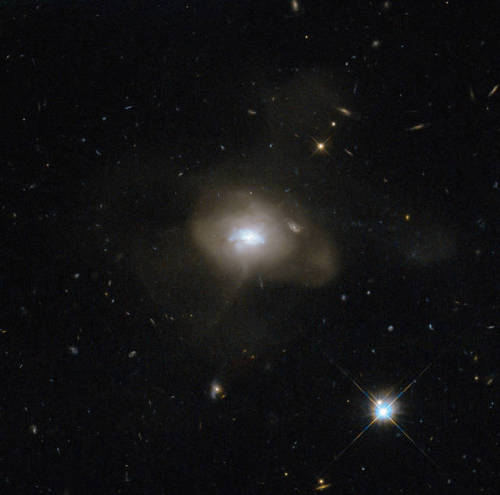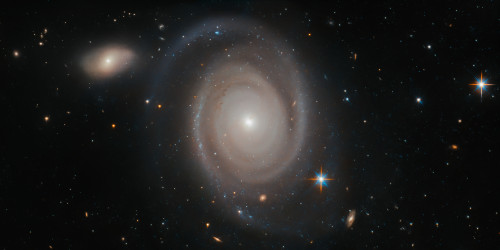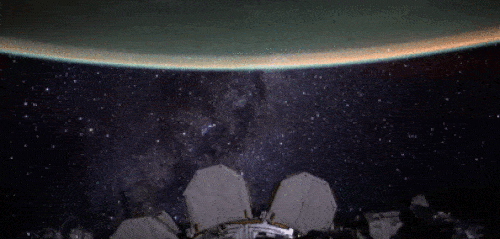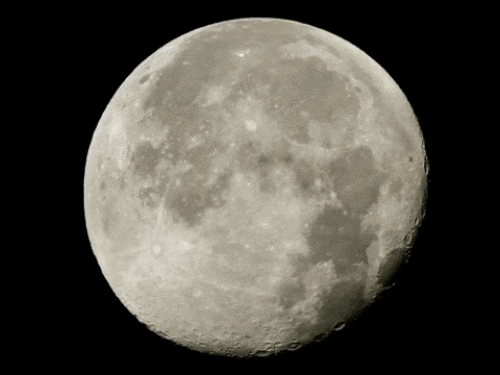When Galaxies Collide — A Common Event In The Universe — A Fresh Burst Of Star Formation Typically

When galaxies collide — a common event in the universe — a fresh burst of star formation typically takes place as gas clouds mash together. At this point, the galaxy has a blue hue, but the color does not mean it is cold: it is a result of the intense heat of newly formed blue–white stars. Those stars do not last long, and after a few billion years the reddish hues of aging, smaller stars dominate an elliptical galaxy's spectrum.
Our Hubble Space Telescope (@NASAHubble) caught sight of a soft, diffuse-looking galaxy, perhaps the aftermath of a long-ago galactic collision when two spiral galaxies, each perhaps much like the Milky Way, swirled together for millions of years.
In such mergers, the original galaxies are often stretched and pulled apart as they wrap around a common center of gravity. After a few back-and-forths, this starry tempest settles down into a new, round object. The now subdued celestial body is technically known as an elliptical galaxy.
Make sure to follow us on Tumblr for your regular dose of space: http://nasa.tumblr.com.
Credit: ESA/Hubble & NASA
More Posts from Nasa and Others
Each year we hold a Day of Remembrance. Today, Jan. 25, we pay tribute to the crews of Apollo 1 and space shuttles Challenger and Columbia, as well as other NASA colleagues who lost their lives while furthering the cause of exploration and discovery.
#NASARemembers
Learn more about the Day of Remembrance HERE.
Make sure to follow us on Tumblr for your regular dose of space: http://nasa.tumblr.com.

Not all galaxies are lonely. Some have galaxy squads.
NGC 1706, captured in this image by our Hubble Space Telescope, belongs to something known as a galaxy group, which is just as the name suggests — a group of up to 50 galaxies which are gravitationally bound and relatively close to each other.
Our home galaxy, the Milky Way, has its own squad — known as the Local Group, which also contains the Andromeda galaxy, the Large and Small Magellanic clouds and the Triangulum galaxy.
Make sure to follow us on Tumblr for your regular dose of space: http://nasa.tumblr.com.
Have you ever been scared while flying? What was the event that scared you the most?What's your favorite plane to fly?
A View into the Past

Our Hubble Space Telescope just found the farthest individual star ever seen to date!
Nicknamed “Earendel” (“morning star” in Old English), this star existed within the first billion years after the universe’s birth in the big bang. Earendel is so far away from Earth that its light has taken 12.9 billion years to reach us, far eclipsing the previous single-star record holder whose light took 9 billion years to reach us.
Though Earendel is at least 50 times the mass of our Sun and millions of times as bright, we’d normally be unable to see it from Earth. However, the mass of a huge galaxy cluster between us and Earendel has created a powerful natural magnifying glass. Astronomers expect that the star will be highly magnified for years.
Earendel will be observed by NASA’s James Webb Space Telescope. Webb's high sensitivity to infrared light is needed to learn more about this star, because its light is stretched to longer infrared wavelengths due to the universe's expansion.
10 Things: Calling All Pluto Lovers
June 22 marks the 40th anniversary of Charon’s discovery—the dwarf planet Pluto’s largest and first known moon. While the definition of a planet is the subject of vigorous scientific debate, this dwarf planet is a fascinating world to explore. Get to know Pluto’s beautiful, fascinating companion this week.
1. A Happy Accident

Astronomers James Christy and Robert Harrington weren’t even looking for satellites of Pluto when they discovered Charon in June 1978 at the U.S. Naval Observatory Flagstaff Station in Arizona – only about six miles from where Pluto was discovered at Lowell Observatory. Instead, they were trying to refine Pluto's orbit around the Sun when sharp-eyed Christy noticed images of Pluto were strangely elongated; a blob seemed to move around Pluto.
The direction of elongation cycled back and forth over 6.39 days―the same as Pluto's rotation period. Searching through their archives of Pluto images taken years before, Christy then found more cases where Pluto appeared elongated. Additional images confirmed he had discovered the first known moon of Pluto.
2. Forever and Always

Christy proposed the name Charon after the mythological ferryman who carried souls across the river Acheron, one of the five mythical rivers that surrounded Pluto's underworld. But Christy also chose it for a more personal reason: The first four letters matched the name of his wife, Charlene. (Cue the collective sigh.)
3. Big Little Moon

Charon—the largest of Pluto’s five moons and approximately the size of Texas—is almost half the size of Pluto itself. The little moon is so big that Pluto and Charon are sometimes referred to as a double dwarf planet system. The distance between them is 12,200 miles (19,640 kilometers).
4. A Colorful and Violent History

Many scientists on the New Horizons mission expected Charon to be a monotonous, crater-battered world; instead, they found a landscape covered with mountains, canyons, landslides, surface-color variations and more. High-resolution images of the Pluto-facing hemisphere of Charon, taken by New Horizons as the spacecraft sped through the Pluto system on July 14 and transmitted to Earth on Sept. 21, reveal details of a belt of fractures and canyons just north of the moon’s equator.
5. Grander Canyon

This great canyon system stretches more than 1,000 miles (1,600 kilometers) across the entire face of Charon and likely around onto Charon’s far side. Four times as long as the Grand Canyon, and twice as deep in places, these faults and canyons indicate a titanic geological upheaval in Charon’s past.
6. Officially Official

In April 2018, the International Astronomical Union—the internationally recognized authority for naming celestial bodies and their surface features—approved a dozen names for Charon’s features proposed by our New Horizons mission team. Many of the names focus on the literature and mythology of exploration.
7. Flying Over Charon
This flyover video of Charon was created thanks to images from our New Horizons spacecraft. The “flight” starts with the informally named Mordor (dark) region near Charon’s north pole. Then the camera moves south to a vast chasm, descending to just 40 miles (60 kilometers) above the surface to fly through the canyon system.
8. Strikingly Different Worlds

This composite of enhanced color images of Pluto (lower right) and Charon (upper left), was taken by New Horizons as it passed through the Pluto system on July 14, 2015. This image highlights the striking differences between Pluto and Charon. The color and brightness of both Pluto and Charon have been processed identically to allow direct comparison of their surface properties, and to highlight the similarity between Charon’s polar red terrain and Pluto’s equatorial red terrain.
9. Quality Facetime

Charon neither rises nor sets, but hovers over the same spot on Pluto's surface, and the same side of Charon always faces Pluto―a phenomenon called mutual tidal locking.
10. Shine On, Charon

Bathed in “Plutoshine,” this image from New Horizons shows the night side of Charon against a star field lit by faint, reflected light from Pluto itself on July 15, 2015.
Read the full version of this week’s ‘10 Things to Know’ article on the web HERE.
Make sure to follow us on Tumblr for your regular dose of space: http://nasa.tumblr.com.

If we could squeeze a galaxy, it would be this fluffy-looking one.
Spiral galaxies like this, located 60 million light-years away, have supermassive black holes at their bright centers. Astronomers are trying to understand this cozy relationship.
Make sure to follow us on Tumblr for your regular dose of space: http://nasa.tumblr.com.
International Space Station

The International Space Station is an important and special place that is built on international cooperation and partnership. The station is a convergence of science, technology and human innovation that benefits and advances our global community here on Earth.

While the space station is an important aspect of our low-Earth orbit exploration, it is also the key to our next giant leap to deep space and our Journey to Mars. For example, our recent VEGGIE experiment aboard the space station is a critical aspect of long-duration exploration missions farther into the solar system. Food grown in space will be a resource for crew members that can provide them will essential vitamins and nutrients that will help enable deep space pioneering.
Another important experiment underway is the Twins Study that involves twin astronauts Scott and Mark Kelly. These investigations will provide insight into the subtle effects and changes that may occur in spaceflight as compared to Earth by studying two individuals who have the same genetics, but are in different environments for one year. You can follow Scott Kelly as he spends a year in space.

The space station is the second brightest object in the sky (after the moon, of course), and you don’t even need a telescope to see it! We can even tell you exactly when and where to look up to Spot the Station in your area!
So, as you look to spot the station in the sky, remember that even though it may look small from Earth, the crew onboard (and at home) are making contributions to international partnerships and global research.
What’s Up for March 2016?
In March, Jupiter, it’s moons and moon shadows will all be visible in the sky. Find out when and where to look up:

Jupiter dominates the evening sky this month, rising at sunset and setting at dawn. On March 8, Jupiter reaches what is called “opposition”. Imagine that Jupiter and the sun are at opposite ends of a straight line, with the Earth in between. This brings Jupiter its closest to Earth, so it shines brighter and appears larger in telescopes.

On the nights of March 14 – 15, March 21 – 22 and March 29, two of Jupiter’s moons will cross the planet’s disk.

When the planet is at opposition and the sun shines on Jupiter’s moons, we can see the moon’s shadow crossing the planet. There are actually 11 of these double shadow transits in March!

The next six months will be awesome times for you to image Jupiter when it’s highest in the sky; near midnight now, and a little earlier each night through the late summer.
Even through the smallest telescopes or binoculars, you should be able to see the two prominent belts on each side of Jupiter’s equator made up of the four Galilean moons: Io, Europa Ganymede and Calisto. If you have a good enough view, you may even see Jupiter’s Red Spot!

Our Juno spacecraft will arrive at Jupiter on July 4th of this year and will go into orbit around the giant planet. Right now, the Juno mission science team is actively seeking amateur and professional images of the planet. These images are uploaded to a Juno website, and the public is invited to discuss points of interest in Jupiter’s atmosphere.

Locations will later be voted on and the favorites will be targets for JunoCam, the spacecraft’s imaging camera. Once JunoCam has taken the images, they’ll be posted online. Imaging participants can then process these raw mission images and re-upload them for others to view.

Make sure to follow us on Tumblr for your regular dose of space: http://nasa.tumblr.com

Home is Where the Astronaut Is…
The International Space Station serves as a home, office and recreation room for astronauts. They share this confined space far above the Earth with crew members from different countries and cultures for as long as six months or more. At the same time, maintaining individual well-being and crew harmony is important for the crew and mission success.
The Culture, Values and Environmental Adaptation in Space (At Home in Space) Investigation, looks at changes in perceptions about home in space and the ways a unique culture may develop aboard the station during a mission. Discover more about this study HERE.
Make sure to follow us on Tumblr for your regular dose of space: http://nasa.tumblr.com
One Hot Year after Another
Globally, 2020 was the hottest year on record, effectively tying 2016, the previous record. Overall, Earth’s average temperature has risen more than 2 degrees Fahrenheit since the 1880s.

Temperatures are increasing due to human activities, specifically emissions of greenhouse gases, like carbon dioxide and methane.
Heat and the energy it carries are what drive our planet: winds, weather, droughts, floods, and more are expressions of heat. The right amount of heat is even one of the things that makes life on Earth possible. But too much heat is changing the way our planet’s systems act.
My World’s on Fire
Higher temperatures drive longer, more intense fire seasons. As rain and snowfall patterns change, some regions are getting drier and more vulnerable to damage, setting the stage for more fires.

2020 saw several record-breaking fires, both in Australia in the beginning of the year, and in the western U.S. through northern summer and fall. Smoke from fires in both regions reached so high into the atmosphere that it formed clouds and continues to travel around the globe today.

In the Siberian Arctic, unusually high temperatures helped drive at least 19 fires in the region. More than half of them were burning peat soil -- decomposed organic materials -- that stores a lot of carbon. Peat fires release vast amounts of carbon into the atmosphere, potentially leading to even more warming.

The Water’s Getting Warm
It wasn’t just fire seasons setting records. 2020 had more named tropical storms in the Atlantic and more storms making landfall in the U.S. than any hurricane season on record.

Hurricanes rely on warm ocean water as fuel, and this year, the Atlantic provided. 30 named storms weren’t the only things that made this year’s hurricane season notable.

Storms like Eta, Delta, and Iota quickly changed from smaller, weaker tropical storms into more destructive hurricanes. This rapid intensification is complicated, but it’s likely that warmer, more humid weather -- a result of climate change -- helps drive it.

The Ice Is Getting Thin
Add enough heat, and even the biggest chunk of ice will melt. That’s true whether we’re talking about the ice cubes in your glass or the vast sheets of ice at our planet’s poles. Right now, the Arctic region is warming about three times faster than the rest of our planet, which has some major effects both locally and globally.

This year, Arctic sea ice hit a near-record low. Sea ice is actually made of frozen ocean water, and it grows and thaws with the seasons, typically reaching an annual minimum extent in September.

Warmer ocean water led to more ice melting this year, and 2020’s annual minimum extent continued a long trend of shrinking Arctic sea ice extent.
A Long Trend
We study Earth and how it’s changing from the ground, the sky, and space. Using data from sensors all around the planet, we calculate the global average temperature, working with our partners at NOAA.
Many other organizations also track global temperature using their own instruments and methods, and they all match remarkably well. The last seven years were the hottest seven years on record. Earth is getting warmer.

We also study the effects of increasing temperatures, like the melting sea ice and longer fire seasons mentioned above. Additionally, we can study the cause of climate change from space, with a bird’s eye view of increasing carbon in the atmosphere.

The planet is changing because of human activities. We’re working together with other agencies to monitor changes and understand what this means for people in the future.
Make sure to follow us on Tumblr for your regular dose of space: http://nasa.tumblr.com.
-
 ravioxd liked this · 4 years ago
ravioxd liked this · 4 years ago -
 bigheart-bigbutt reblogged this · 4 years ago
bigheart-bigbutt reblogged this · 4 years ago -
 nancyxj liked this · 4 years ago
nancyxj liked this · 4 years ago -
 spaxey reblogged this · 5 years ago
spaxey reblogged this · 5 years ago -
 ntsclbkwrm reblogged this · 5 years ago
ntsclbkwrm reblogged this · 5 years ago -
 ntsclbkwrm liked this · 5 years ago
ntsclbkwrm liked this · 5 years ago -
 azurilmare reblogged this · 5 years ago
azurilmare reblogged this · 5 years ago -
 sailor-goon liked this · 5 years ago
sailor-goon liked this · 5 years ago -
 catyuy reblogged this · 6 years ago
catyuy reblogged this · 6 years ago -
 myrathepeach liked this · 6 years ago
myrathepeach liked this · 6 years ago -
 twinxion liked this · 6 years ago
twinxion liked this · 6 years ago -
 time-doesnt-wait- liked this · 6 years ago
time-doesnt-wait- liked this · 6 years ago -
 stephphs liked this · 6 years ago
stephphs liked this · 6 years ago -
 sahaddai reblogged this · 6 years ago
sahaddai reblogged this · 6 years ago -
 princessedesanges liked this · 6 years ago
princessedesanges liked this · 6 years ago -
 mouseinscrubs reblogged this · 7 years ago
mouseinscrubs reblogged this · 7 years ago -
 hherekore liked this · 7 years ago
hherekore liked this · 7 years ago -
 lutefisk-kingdom reblogged this · 7 years ago
lutefisk-kingdom reblogged this · 7 years ago -
 lutefisk-kingdom liked this · 7 years ago
lutefisk-kingdom liked this · 7 years ago -
 mnwkd-blog liked this · 7 years ago
mnwkd-blog liked this · 7 years ago -
 lickrock reblogged this · 7 years ago
lickrock reblogged this · 7 years ago -
 oddp1ant reblogged this · 7 years ago
oddp1ant reblogged this · 7 years ago -
 tigerlvr1220 liked this · 7 years ago
tigerlvr1220 liked this · 7 years ago -
 bangtansuga liked this · 7 years ago
bangtansuga liked this · 7 years ago -
 tokyoknj liked this · 7 years ago
tokyoknj liked this · 7 years ago -
 riceli liked this · 7 years ago
riceli liked this · 7 years ago -
 fleurdebach5-blog liked this · 7 years ago
fleurdebach5-blog liked this · 7 years ago -
 florosies reblogged this · 7 years ago
florosies reblogged this · 7 years ago -
 binnie-remade liked this · 7 years ago
binnie-remade liked this · 7 years ago -
 themercurygirl reblogged this · 7 years ago
themercurygirl reblogged this · 7 years ago -
 gucu reblogged this · 7 years ago
gucu reblogged this · 7 years ago -
 jayuisnear reblogged this · 7 years ago
jayuisnear reblogged this · 7 years ago -
 cryyra reblogged this · 7 years ago
cryyra reblogged this · 7 years ago -
 marvi-jude94 liked this · 7 years ago
marvi-jude94 liked this · 7 years ago -
 ven-owns-my-heart liked this · 7 years ago
ven-owns-my-heart liked this · 7 years ago -
 xaihi reblogged this · 7 years ago
xaihi reblogged this · 7 years ago -
 importnant reblogged this · 7 years ago
importnant reblogged this · 7 years ago
Explore the universe and discover our home planet with the official NASA Tumblr account
1K posts